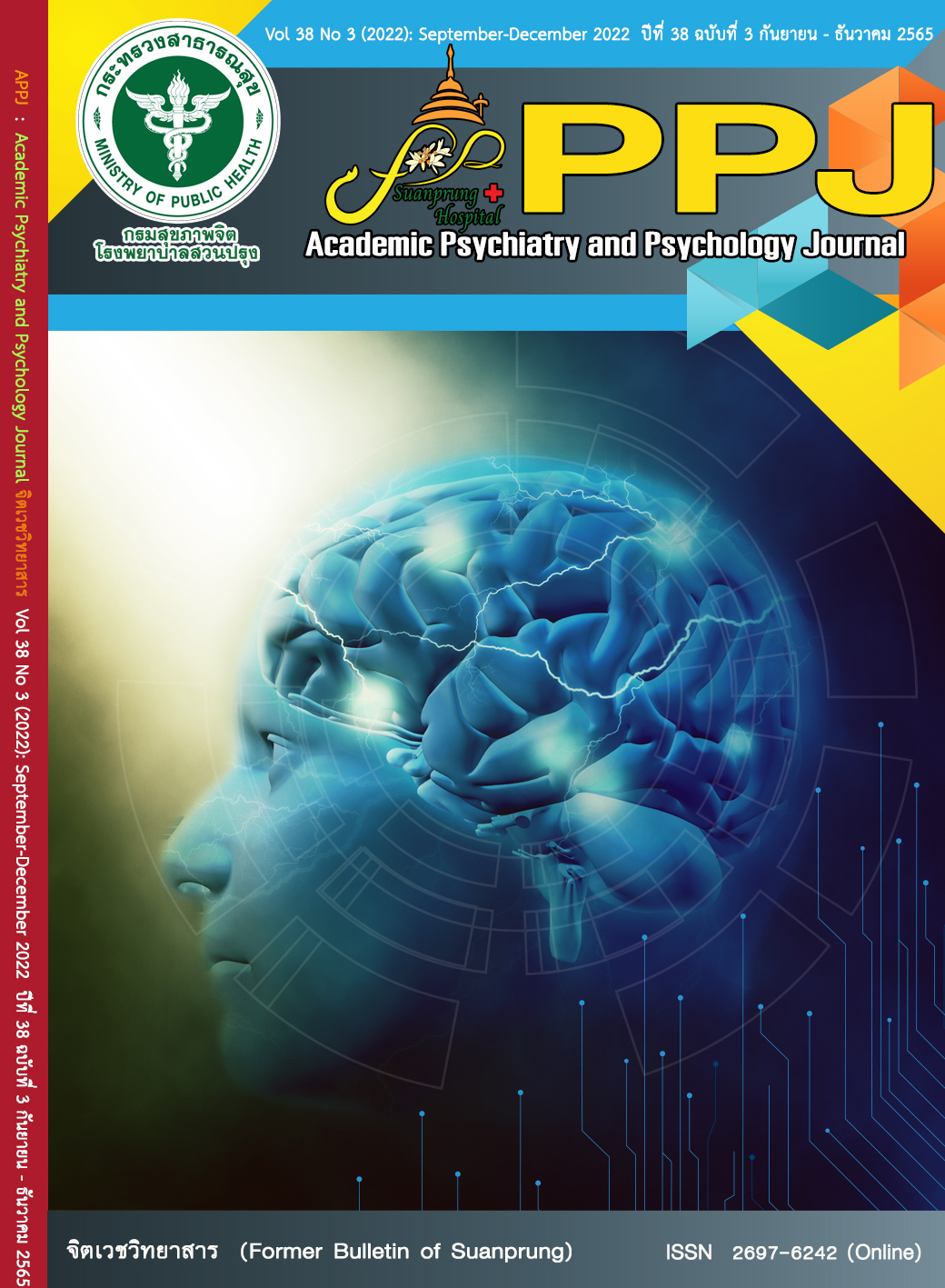Agreement and correlation between PHQ-9 and HAMD in patients in remission or with mild symptoms of major depressive disorder
Main Article Content
Abstract
Objective: To analyze the agreement and correlation between the sum scores of Patient Health Questionnaire (PHQ-9) and Hamilton Depression Rating Scale (HAMD) in patients in remission or with mild symptoms of major depressive disorder attending the outpatient service of Srithanya Hospital from June to September 2021.
Methods: Secondary data were obtained from 107 patients with HAMD-17 scores of 18 points or less. PHQ-9 and HAMD-17 were applied by interviewing the patient during the same visit. Descriptive statistic was used. The coefficient correlations were analyzed by intraclass correlation (ICC) and Pearson’s r among PHQ-9, HAMD-17, and selected items of HAMD such as HAMD-6 and HAMD part anxiety-depression (HAMD-AD).
Results: Most patients were female (69.4%) and had been diagnosed with a single episode of major depression (F32) at 74.8%. The mean age was 36.9 years old. The mean scores of PHQ-9, HAMD-17 were 7±2.8 & 9.1±3.8, respectively. ICC(95%CI) between HAMD-17 & PHQ-9, HAMD-6&PHQ-9, HAMD-AD& PHQ-9 were 0.79 (0.65,0.84), 0.85(0.79,0.90) & 0.91(0.86, 0.94), respectively. Pearson’s r ranged from 0.54 to 0.68.
Conclusion: The sum scores of PHQ-9 were strongly concordant with those of HAMD-17, HAMD-6, and HAMD-AD in major depressive patients who were in remission or presented mild symptoms.
Article Details

This work is licensed under a Creative Commons Attribution-NonCommercial-NoDerivatives 4.0 International License.
บทความหลังผ่านการปรับแก้จากกองบรรณาธิการแล้ว เป็นลิขสิทธ์ของวารสารจิตเวชวิทยาสาร โรงพยาบาลสวนปรุง กรมสุขภาพจิต กระทรวงสาธารณสุข ห้ามเผยแพร่เพื่อประโยชน์ทางการค้าโดยไม่ได้รับอนุญาต แต่อนุญาตให้เผยแพร่บทความดังกล่าวเพื่อประโยชน์ทางการศึกษาแก่ประชาชนทั่วไป ทั้งนี้กองบรรณาธิการไม่จำเป็นต้องเห็นด้วยกับบทความหรือข้อคิดเห็นใดๆ ที่ปรากฏในวารสารสวนปรุง
References
Reddy M. Depression: the disorder and the burden. Indian J Psychol Med
;32(1):1-2.
Collaborators GMD. Global, regional, and national burden of 12 mental disorders in 204 countries and territories, 1990–2019: a systematic analysis for the Global Burden of Disease Study 2019. Lancet Psychiat. 2022.
Maurer D, Raymond T, Davis B. Depression: screening and diagnosis. J Am Fam Psy. 2018;98(8):508-15.
Common mental health problems: identification and pathways to care In: NICE, editor. 25 May 2011.
Tepkhamram P. Department of Mental Health stressed "depression is treatable"
Thai Health Promotion Foundation
[Available from: https://www.thaihealth.or.th/Content/28637-กรมสุขภาพจิตย้ำ%20‘ซึมเศร้า’%20รักษาได้%20.html.
Negeri Z, Levis B, Sun Y, He C, Krishnan A, Wu Y, et al. Accuracy of the Patient Health Questionnaire-9 for screening to detect major depression: updated systematic review and individual participant data meta-analysis. Brit Med J. 2021;375.
Thompson A, Liu H, Hays R, Katon WJ, Rausch R, Diaz N, et al. Diagnostic accuracy and agreement across three depression assessment measures for Parkinson’s disease. Parkinsonism Related Disord. 2011;17(1):40-5.
Jiraniramai S, Wongpakaran T, Angkurawaranon C, Jiraporncharoen W, Wongpakaran NJND, Treatment. Construct validity and differential item functioning of the PHQ-9 among health care workers: Rasch Analysis approach. 2021;17:1035.
Davis K, Pearlstein T, Stuart S, O’Hara M, Zlotnick CJAowsmh. Analysis of brief screening tools for the detection of postpartum depression: comparisons of the PRAMS 6-item instrument, PHQ-9, and structured interviews. 2013;16(4):271-7.
Hamilton M. A rating scale for depression. J Neurol Neurosurg Psychiatr. 1960;23(1):56.
Bagby R, Ryder A, Schuller D, Marshall M. The Hamilton Depression Rating Scale: has the gold standard become a lead weight? Am J Psychiatr. 2004;161(12):2163-77.
Bech P, Wilson P, Wessel T, Lunde M, Fava M. A validation analysis of two self‐reported HAM‐D6 versions. J Act Psychiat Scand. 2009;119(4):298-303.
Dunlop BW, Parikh SV, Rothschild AJ, Thase ME, DeBattista C, Conway CR, et al. Comparing sensitivity to change using the 6-item versus the 17-item Hamilton depression rating scale in the GUIDED randomized controlled trial. 2019;19(1):1-10.
Ma S, Yang J, Yang BX, Kang L, Wang P, Zhang N, et al. The Patient Health Questionnaire-9 versus the Hamilton Rating Scale for Depression in assessing major depressive disorder. 2021:1974.
Sun Y, Fu Z, Bo Q, Mao Z, Ma X, Wang CJBp. The reliability and validity of PHQ-9 in patients with major depressive disorder in psychiatric hospital. 2020;20(1):1-7.
Samuthrsindh P, Silpakit O, Chomchuen R. Efficacy of vitamin D supplementation in patients diagnosed with major depressive disorder and vitamin D insufficiency or deficiency: an open-label study. J Ment Health Thai. 2022;30(1):1-12.
Seeherunwong A & Kongsakorn R. Thai Version of Hamilton Rating Scale for Depression : Cluster analysis. J Psychiatr Assoc Thailand.46(4):311-21.
Lotrakul M, Sumrithe S, Saipanish RJBp. Reliability and validity of the Thai version of the PHQ-9. 2008;8(1):1-7.
Koo TK, Li MYJJocm. A guideline of selecting and reporting intraclass correlation coefficients for reliability research. 2016;15(2):155-63.
Akoglu H. User's guide to correlation coefficients. Turk J Emerg Med. 2018;18(3):91-3.
Li Y, Aggen S, Shi S, Gao J, Tao M, Zhang K, et al. Subtypes of major depression: latent class analysis in depressed Han Chinese women. Psychol Medicine
;44(15):3275-88.
Yutrirak K, Ratta-apha W, Dankulchai P, Pukrittayakamee PJSMJ. Psychometric Properties of the PHQ-9, HADS, and CES-D Questionnaires and the Prevalence of Depression in Patients with Cancer Receiving Radiotherapy. 2021;73(12):793-800.

